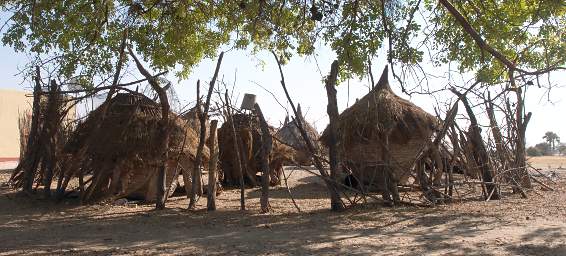
While teaching at Ponhofi for the summer, Dona and I had been hoping to do some traveling on weekends; but we were so busy it wasn't until late in our stay that we managed to get away. Her parents had visited Huab Lodge twenty or so years ago and really enjoyed it. It was, and still is, owned and operated by Jan and Suzie Van de Reep, a delightful pair. When we called about making a reservation, Suzie informed us it was not the best time because it was high season. We worked around that and found a weekend that would work, we made a reservation, and a reservation for a rental car.
The rental car was in Ondangwa, the large town about 50 km south of us. We wanted to get an early start so I hitched down to pick it up the afternoon before. The car wasn't ready, so I had to wait a bit. I parked myself under some Mopane trees near a bunch of mahangu storage baskets outside a family living compound across from the shopping center and looked for birds. Up until then I knew people stored millet for the course of a year, but I didn't realize how. I had assumed it would be in some kind of wooden bin, and was surprised to see huge baskets being used. These baskets appeared to be sitting right on the ground, which surprised me as I thought they would be elevated in case of flooding.
 |
| Mahangu Storage |
I managed to spot a few birds, some which I could recognize and some which I could not; and some cool lizards.
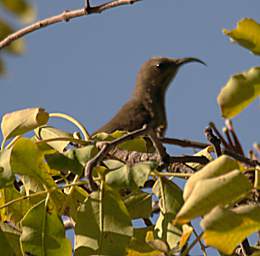 |
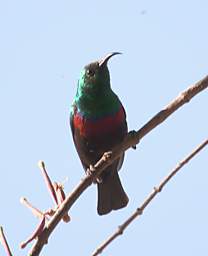 |
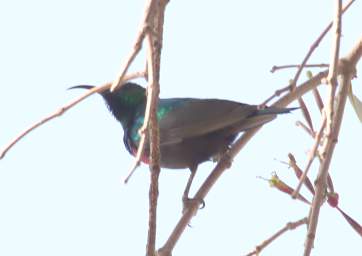 |
| Xxx Sunbird | Marico Sunbird | |
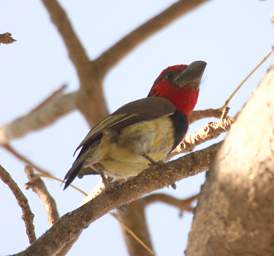 |
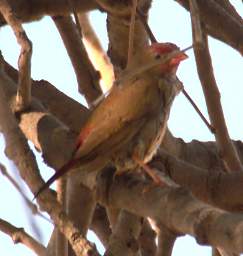 |
| Black Collared Barbet | Xxx |
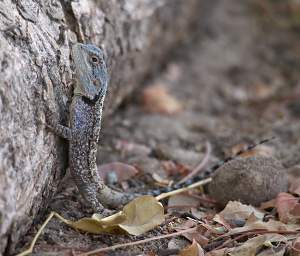 |
| Xxx Southern Rock Agama |
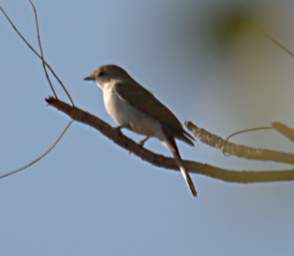 |
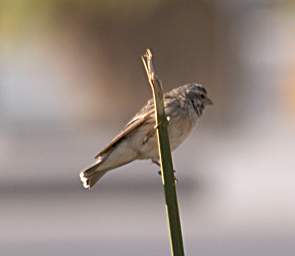 |
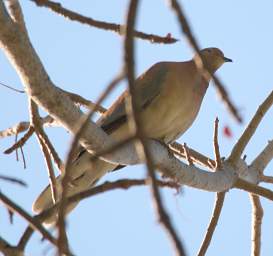 |
| Xxx Marico Flycatcher | Xxx Sparrow | Laughing Dove |
Women in Namibia carry everything on their heads. It must be easier, somehow. It certainly makes good sense, since it frees up both hands. But I've always wondered how it is on one's back. Perhaps it promotes better posture, and therefore saves the back rather than compressing the vertebrae, which is what it seems like it would do.
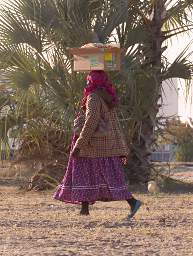 |
| Woman Walking |
After picking up the car I headed back, and noticed the sign Will, Hattie, and Ella, our neighbors back in Montana, had tried to mimic. Not too bad, considering they didn't know the name of the place.
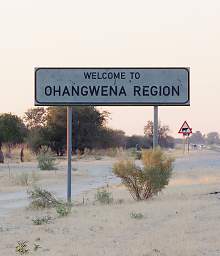 |
| Ohangwena Sign |
One of the cool things about Namibia is they understand road trips. Their roads all have frequent pull-offs with picnic tables and rubbish bins, generally under a large spreading tree for shade. These rest areas are every 40 km or so, rather than every few hundred miles the way they are in the U.S.A.. They're pretty convenient when you want to stop for a rest or a bite to eat.
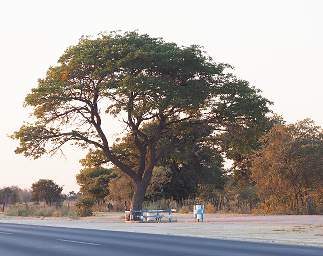 |
| Roadside Table |
We stopped whenever we could when we saw birds, and were often rewarded with a new species we hadn't seen before. Some we could identify, and some are still a mystery, like the black one below. I think it's either a Pale Winged Starling or a Fork-Tailed Drongo. But the starling has a bright orange, not red, eye; and the tail isn't visible enough to see its shape.
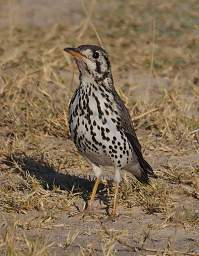 |
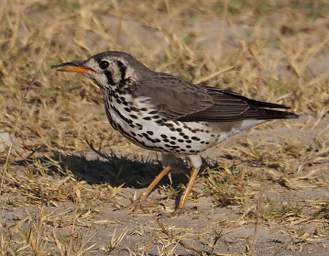 |
| Groundscraper Thrush | |
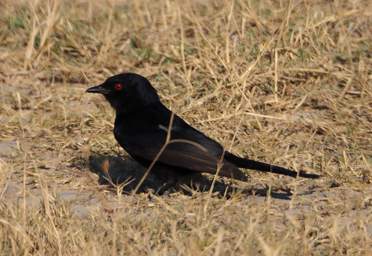 |
| Xxx Starling Drongo |
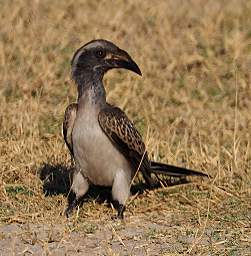 |
 |
| African Grey Hornbill | |
It's a long drive from Ohangwena to Huab Lodge, mostly on good two-lane roads. We took a few "short-cuts" to see more of the countryside, and picked up various hitch-hikers along the way. One of them was working for the Ministry of Agriculture and had been out and about helping put ear-tags in cattle. Apparently there is a problem with cattle rustling between the Owambo and Kunene areas and the hope is that tagged animals will lessen that.
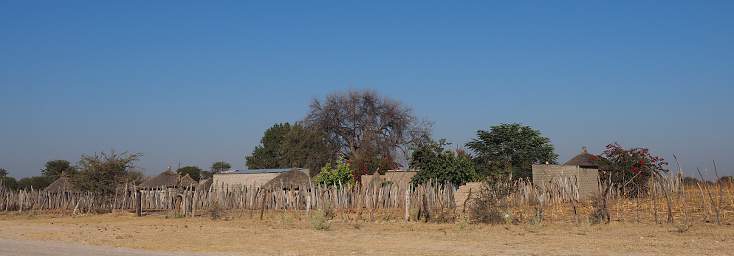 |
| Typical Owambo Family Compound |
We had been driving on one of our short-cuts for a while, down a gravel road, when we came to a big freeway-class road sign. It was a bit of a surprise. In contrast to Tanzania, which doesn't seem to have signs anywhere except occasionally on the main paved thoroughfares, Namibia has done a good job of signing its roads. And while they may be gravel, at least in the dry season they go where the sign says they go.
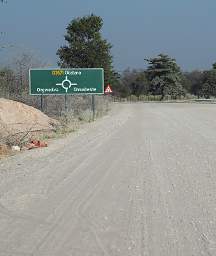 |
| Dirt Road with Fancy Sign |
Few of the roads in Namibia are paved; most are gravel or packed sand, and many are pretty coarse. The combination of dust and heat and rough roads is hard on vehicles, not to mention driving habits. It is not at all uncommon to see dead car bodies parked under a tree, slowly weathering away.
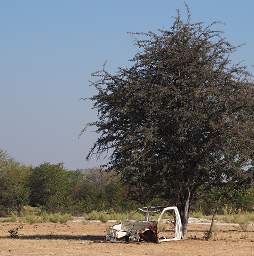 |
| Rusted Car Body |
Much of Northern Namibia is flat. At least the land of the Owambo people is flat. There are huge salt pans, such as the one at Etosha National Park, and even the bush is flat. If it weren't for the bushland, I swear you could set up a transit and walk in a straight line in any direction for 50 km and hold the stick and it would be close to level. It's that flat. When the Okavango River floods in a heavy rain year, huge amounts of land are flooded. You can see the reflection from the water over large areas in satellite images.
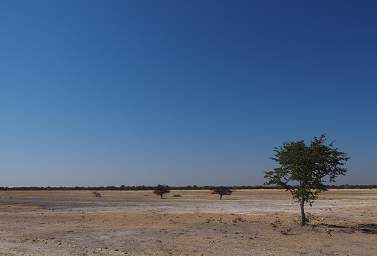 |
| Flat Land |
Much of Northern Namibia looks somewhat uninhabited but really isn't; our village looked small, but only because you couldn't easily see very far. If you start walking down any road, you keep coming to more housing compounds. Most families have some livestock, typically goats or cattle or pigs. And livestock needs a place to graze. Some families have their own grazing land, and others use communal land. There's usually someone attending the livestock, and they with such a dry environment, they are constantly moving about. It's not uncommon to have to slow down and wait for them to cross the road.
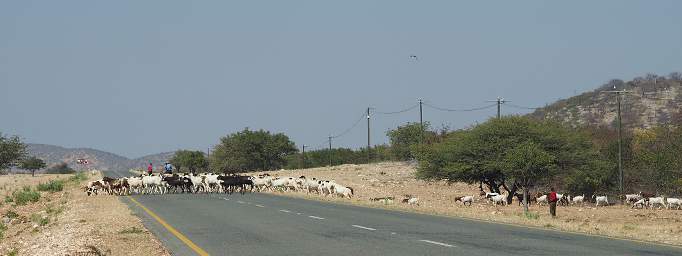 |
| Goats Crossing Road |
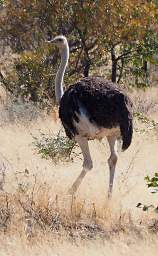 |
| Common Ostrich |
We stopped at Kamanjab to fill up on petrol and pick up the key to the gate to Peet Alberts Koppie, a site on private land which is a National Monument which contains some excellent rock art. While not far off the road it appears infrequently visited, and we had it to ourselves. We were delighted with the abundance of art and the local birds, reptiles and fauna. The rock engravings are mostly of animals, but also includes some geometric shapes. It seemed like every possible surface had been used, and we had to be careful where we walked.
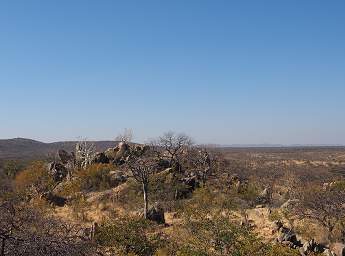 |
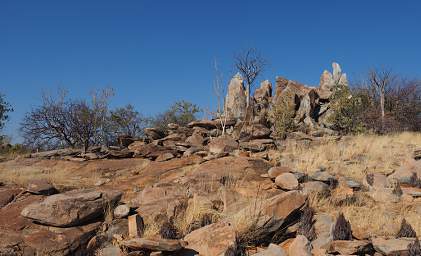 |
| Peet Alberts Koppie | |
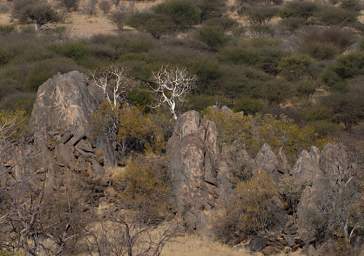 |
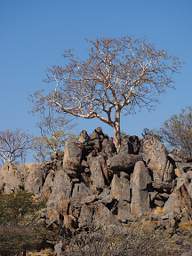 |
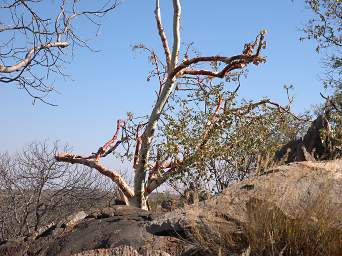 |
| Mountain Chestnut | ||
 |
| Bottle Tree |
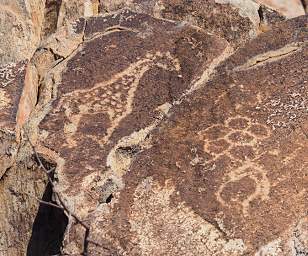 |
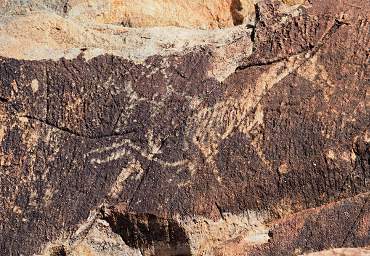 |
 |
| Rock Art, Peet Alberts Koppie | ||
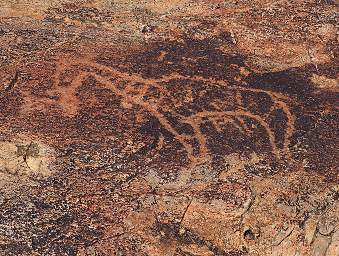 |
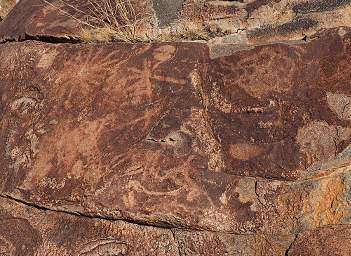 |
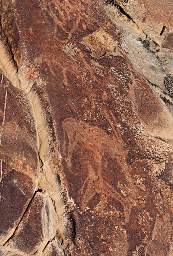 |
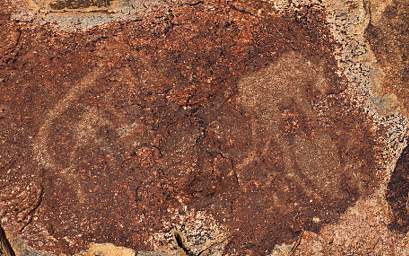 |
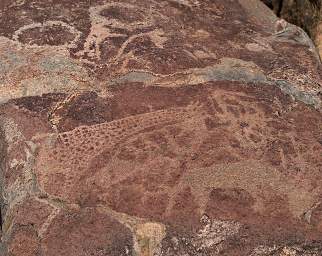 |
 |
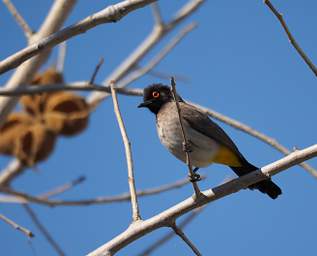 |
| African Red Eyed Bulbul | |
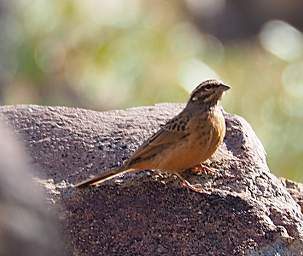 |
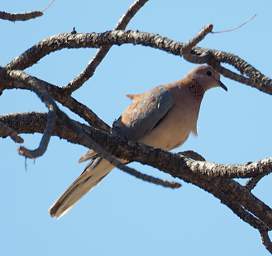 |
| Cinnamon Breasted Bunting | Laughing Dove |
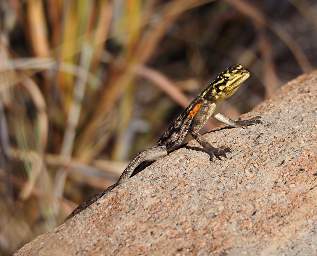 |
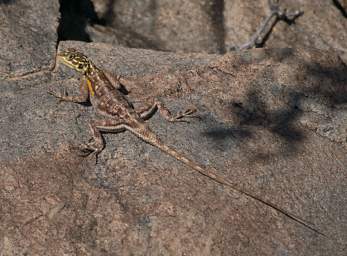 |
| Rock Agama (Female) | |
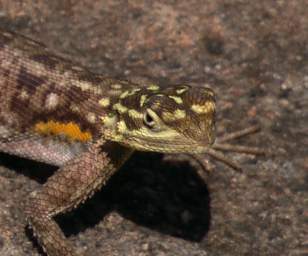 |
 |
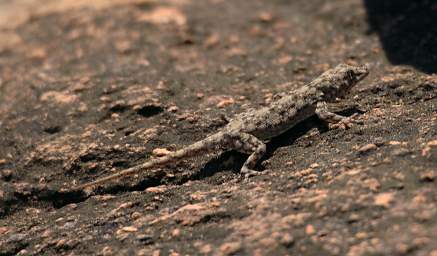 |
 |
| Boulton's Namib Day Gecko | Xxx Skink |
We continued on towards the turnoff to Huab Lodge, crossing the mighty Huab River. It was totally dry; I would love to see it in flood. The landscape had changed from flat to slightly hilly, and off to the southwest we could see more interesting looking topography. We turned off onto the sand track that led to Huab Lodge. Eventually, the hills got bigger and more rugged; the sand turned to grass; occasionally, animals appeared.
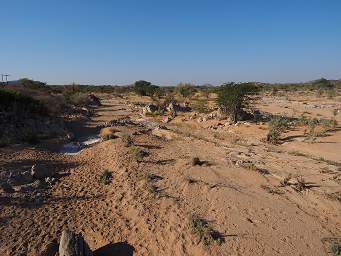 |
 |
| Huab River | |
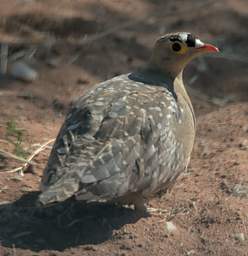 |
 |
| Double Banded Sandgrouse | |
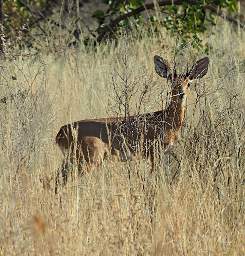 |
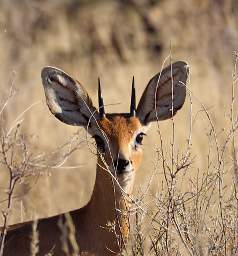 |
| Dikdik | |
We took our time, enjoying the change in our surroundings and the glow of late-afternoon light. As we neared the lodge itself, we noticed huge dinner-plate sized tracks in the road. At the same time a Land Rover appeared, driven by Jan Van de Reep who greeted us heartily and told us the elephant had come through the night before, one of the first elephants they had seen in a long time.
If you look at a map of Namibia, you can see that the Huab River forms an artery going from the area south of Etosha National Park to the coast. In pre-European settlement times, all of these rivers must have had large populations of elephants moving up and down them seasonally. Sadly, there are few left; their environment has been severely restricted, hunting has decimated their numbers, and overgrazed farms have destroyed the arteries of habitat they need for migrations.
 |
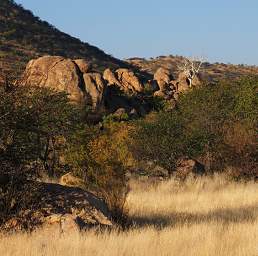 |
| Mountain Chestnut | |
Huab Lodge, like many places in Namibia, is off the grid. Way off the grid. It has its own solar power plant which has been operating for decades. We had a delightful bungalow and wish we could have stayed for weeks.
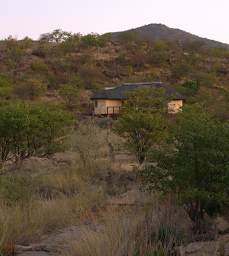 |
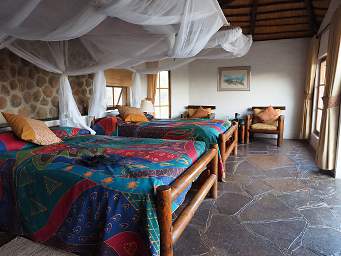 |
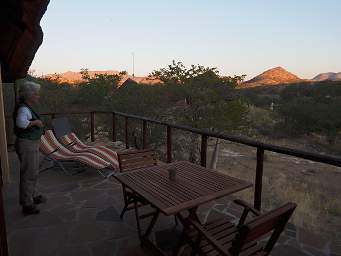 |
| Our Bungalow at Huab | Our Room | Our Balcony |
The river at Huab Lodge was not quite dry; there were seeps here and there which formed small pools, frequented by animals. The floodplain was stuffed full of reeds and grasses and the banks lined with trees.
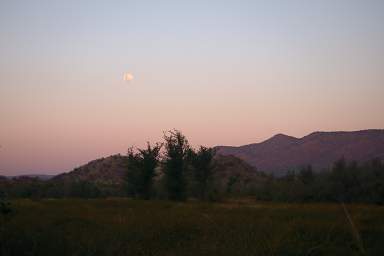 |
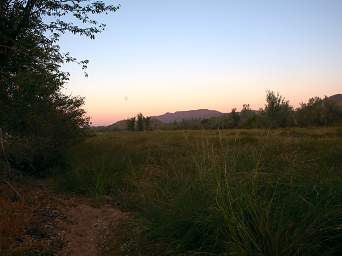 |
| Moon near Sunset, Huab Lodge | Sunset over the Huab River |
Meals at Huab were hearty, served family style. We enjoyed conversations with other visitors from Holand and Belgium. Susie and Jan (pronounced "Yan") told stories of their time here and the wildlife they had seen.
Prior to Huab, Jan and Susie had worked in the Etosha Park area. When they bought the Huab Lodge area, it had been a ranch and was severely overgrazed; in similar condition to some of the land we saw on the way in. They ceased grazing and waited for the grass and other plants to re-establish themselves; the animals followed. It was a slow process, but immensely rewarding. Unfortunately, the land to the north of them is communally grazed, and suffers from the Tragedy of the Commons. Some of the land immediately to the east of them is managed for the benefit of wildlife as well, although that land has recently changed hands and its use may change.
One story Jan told was of an elephant that had died in Etosha. The night it died, the whole herd of which it was a part came and all put their tusks on it as if to say good-bye. It reminded me of a story we heard while in Tanzania of an elephant which accidentally broke a boy's leg. That elephant dragged the boy to the shaded area of a tree and stayed with him overnight, protecting him from hyenas and other predators and scavengers until people from his village arrived to save him. Only then did it cautiously back off.
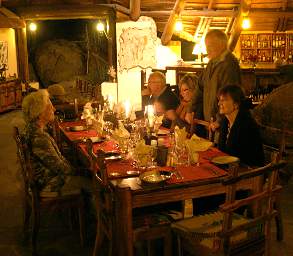 |
| Dinner at Huab Lodge |
In the morning we headed out for a walking trip with Jan. His knowledge of the area's ecology was amazing, and he pointed out plants, animal sign, and other features. The Comifora Notijura (Perfume) tree was used for incense by the Himba dnd the Catholic Church; baboons eat the bark, and the native people break off the end of a shoot and chew it as a toothbrush. He showed us how the arrowhead shaped seedhead of the Bushman Grass spirals into the soil to plant itself; and I learned the Tamarisk, so despised as a foreign invader along the rivers of the American Southwest, is native to Namibia and tolerates saline soils.
We were on our way before sunrise after a hot drink, in time to watch the sun come up from a nice viewpoint. As you can see in the photos, it's cool even in this part of the country in the early morning in winter.
 |
| Heading Out With Jan |
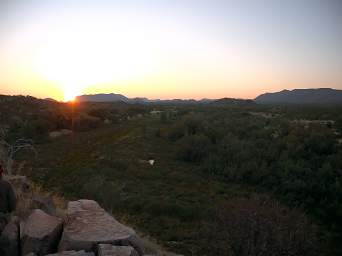 |
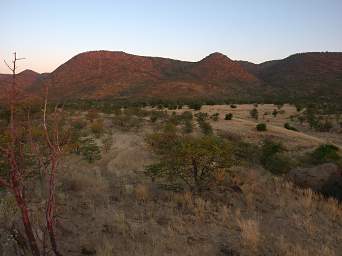 |
| Huab Sunrise | Huab |
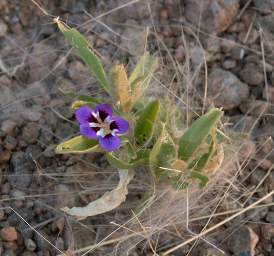 |
| Damara Violet |
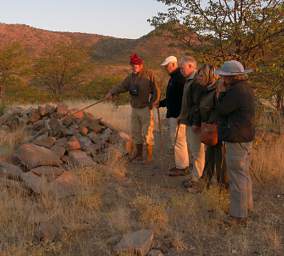 |
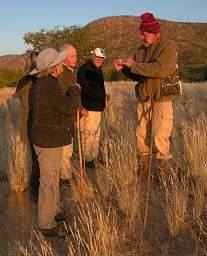 |
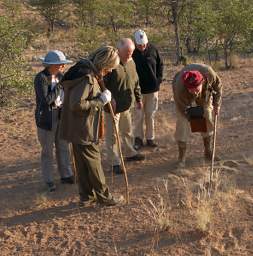 |
| Lesson With Jan | Jan showing us a Spiraling Grass Seed | Lesson With Jan |
The more I learn about termites, the more I'm fascinated by them. There are huge termite mounds all over much of eastern and southern Africa, the only places I've visited. But Jan pointed down to a grass plant where a mound was just forming. It would be interesting to mark something like that and follow it as part of one's morning ritual.
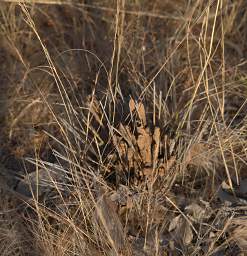 |
| Early Formation of a Termite Mound |
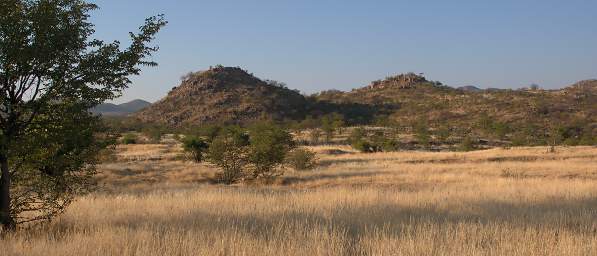 |
| Huab |
On one of our walks we came to a tree which contained bones from an old leopard kill. I'm sort of surprised they are even still there, since bones disappear pretty quickly in Africa in general. But maybe because they were in a tree some of the primary bone crunchers couldn't get at them.
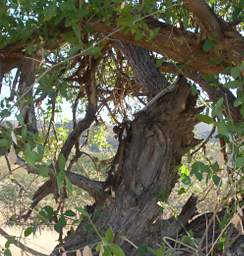 |
| Bones From an old Leopard Kill |
Jan and Susie remembered Dona's parents visit of 20 years ago, partly because they stayed longer than most guests. They showed us their guest book and we soon found the picture of them taken in 1994!
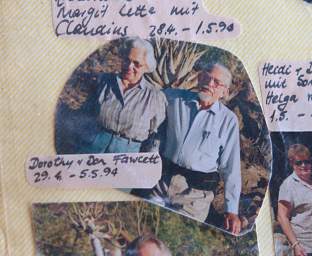 |
| Photo of Dona's Parents,
Don and Dorothy Fawcett, on their visit to Huab Lodge 20 years ago |
While this wasn't the best time to visit for birding, we did enjoy seeing a number of birds.
 |
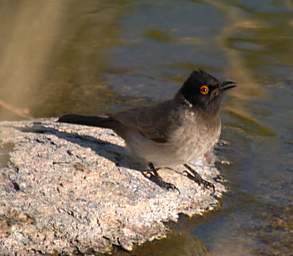 |
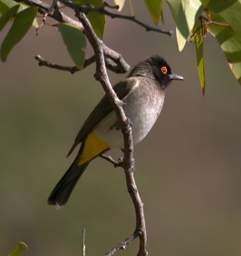 |
| African Red Eyed Bulbul | ||
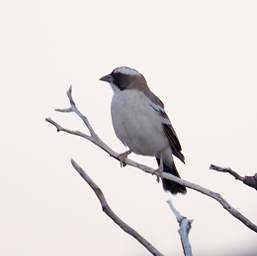 |
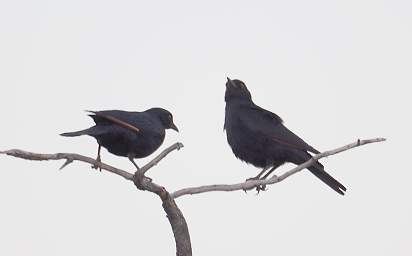 |
| White Browed Sparrow Weaver | Pale Winged Starling |
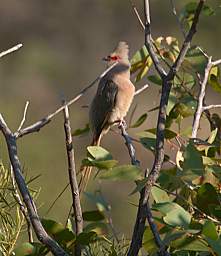 |
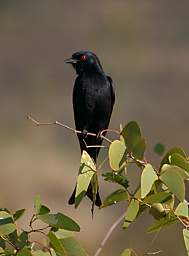 |
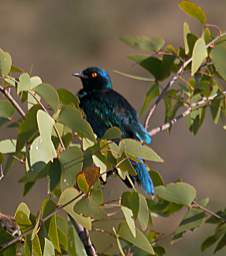 |
| Red Faced Mousebird | Fork Tailed Drongo | Cape Glossy Starling |
 |
 |
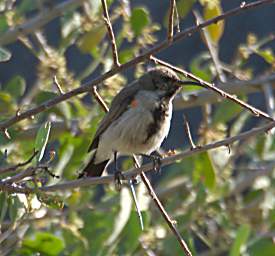 |
| Dusky Sunbird | ||
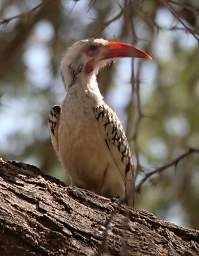 |
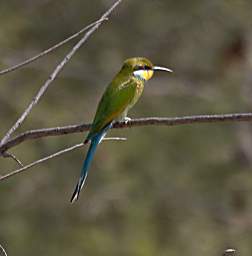 |
| Southern Red Billed Hornbill | Swallow Tailed Bee Eater |
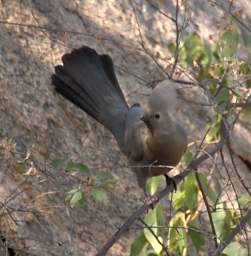 |
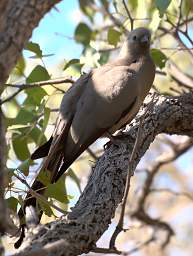 |
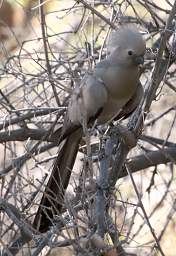 |
 |
| Grey Go Away Bird | |||
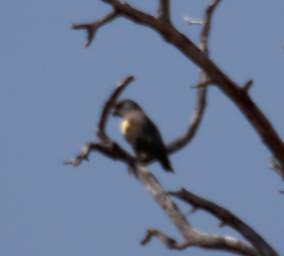 |
| Ruppells Parrot |
We were really hoping to see the elephant which had come through the night before we arrived. We found tracks numerous places, but no elephant. Instead, we saw Kudu, Oryx, and Springbok.
We were also hoping to see Hartmann's Mountain Zebra, an endangered species found only in Namibia and southern Angola. The Zebras in most parts of Namibia are Burchell's Zebras, also known as the Common or Plains Zebra (Technically they are a subspecies of the Plains Zebra). and have stripes which go all around their bodies including the belly. The Burchell's dark stripes also alternate between black and brown, giving it a unique 3-color striped appearance. Mountain Zebras have a stripe-less belly and a dewlap.
Late in the evening on our first game drive we were lucky enough to spot a few Hartman's Mountain Zebras. They were shy animals, and disappeared into the bush in short order.
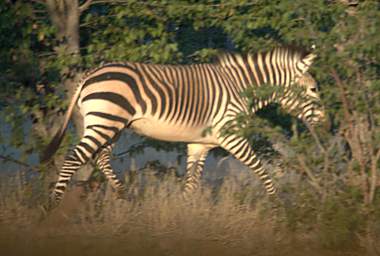 |
| Hartmans Mountain Zebra |
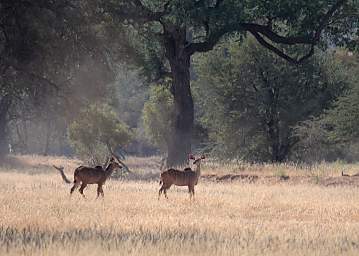 |
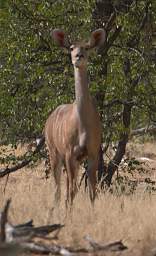 |
| Kudu | |
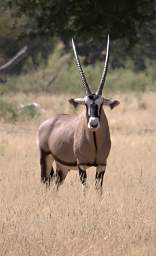 |
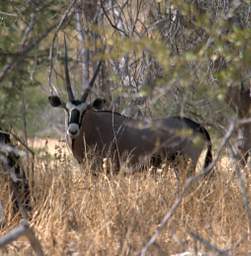 |
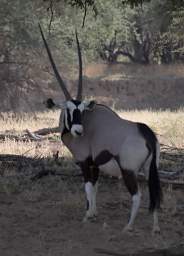 |
 |
| Oryx | |||
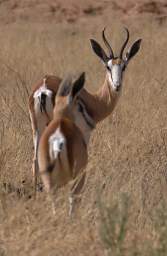 |
 |
| Springbok | Springbok Youngster |
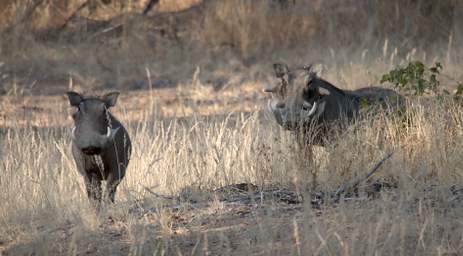 |
| Warthogs |
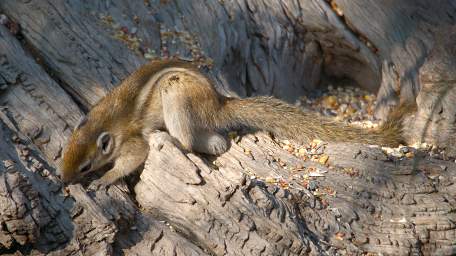 |
| African Striped Ground Squirrel |
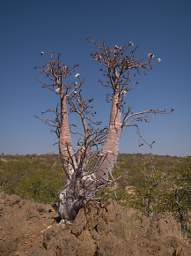 |
| Bottle Tree (Pachypodium Lealii) |
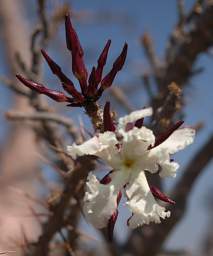 |
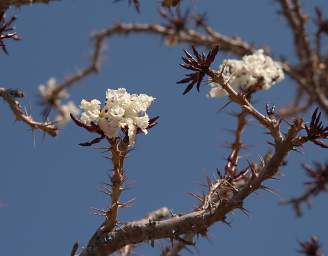 |
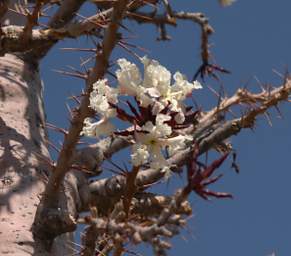 |
| Bottle Tree Blossoms | ||
We were constantly on the lookout for any of Namibia's several species of water-harvesting beatles; their shells have evolved to condense water vapor, which they then drink; and we found some.
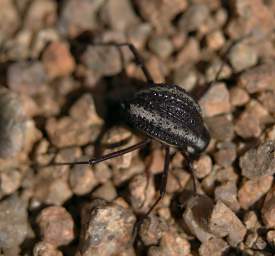 |
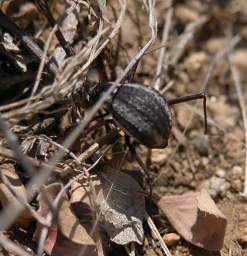 |
| Beatle | |
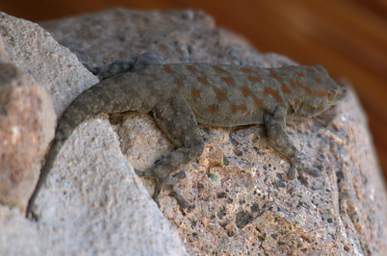 |
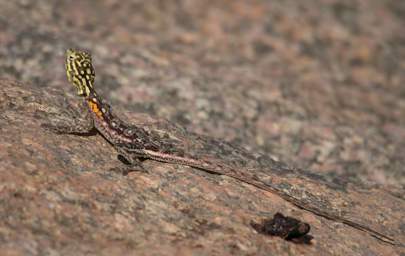 |
| Boulton's Namib Day Gecko | Rock Agama (Female) |
 |
| Moth |
There was a really cool bright orange dragonfly hanging around.
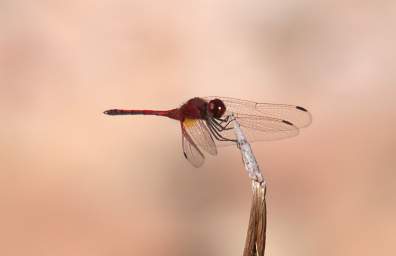 |
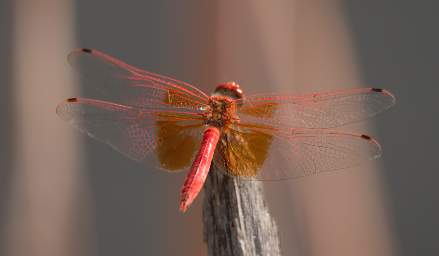 |
We only had a few days at Huab, but they were busy. We started with a one to two hour walk with Jan, then had a "game drive" after breakfast. When people in Africa talk about a "game drive" they mean driving around in a vehicle looking for game. At least that's what our experience has been. That's different from what I usually think of when I hear the expression -- I think of a bunch of people on the ground or in vehicles beating the bush and making noise to "drive" game in a particular direction, usually so hunters can shoot them. I was a bit confused when I first heard the expression.
Then we would rest, relax, wander around, soak in the hot spring during the mid-day lull, and go for another game drive in the evening. The evening light was always delightful.
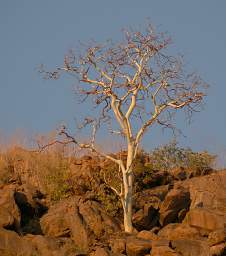 |
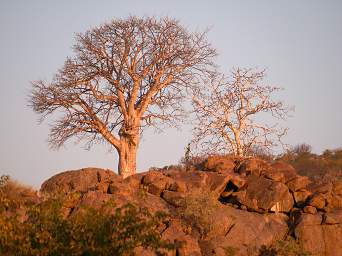 |
| Mountain Chestnut | |
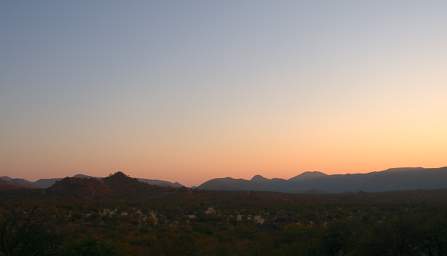 |
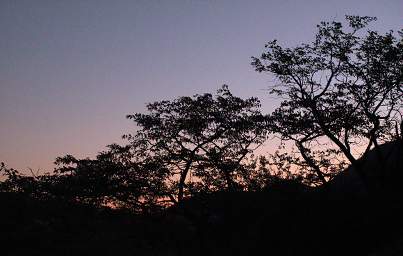 |
| Huab Sunrise | Huab Sunset |
I enjoyed learning more about the night sky in the southern hemisphere, and finally got a good mental image of the Southern Cross (a constellation, officially known as "Crux"), how to locate it, and how it relates to true south.
To find south using the Southern Cross, imagine two lines. One line perpendicularly bisects the axis connecting the two pointer stars. The other line connects the "top and bottom" stars of the Crux -- the two stars farthest apart. Where those two lines intersect is very close to the direction of true south. The point of crossing may be below the horizon, as it is in this case (it's out of the picture on the bottom; but it's also below the horizon, which you can't see).
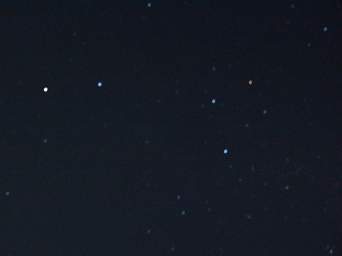 |
 |
| The Pointers (Two bright stars on left)
Southern Cross (Five-star Diamond on Right) |
Finding South Using the Southern Cross |
Our last night at Huab was clear and calm. A number of people had arrived as new guests, and it was a perfect evening for a braai (outdoor bar-b-cue). So we did. Neville, Jan's "right hand man" who helped with various projects, was braai-meister. Susie's "right-hand-woman", whose name I can't remember but who is a great cook, supervised. We all sat down to an elegant table by candlelight under the stars. Yumm!
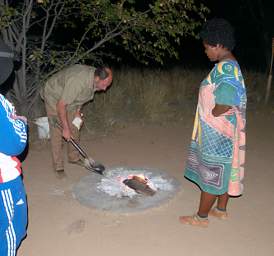 |
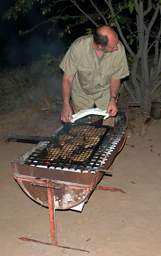 |
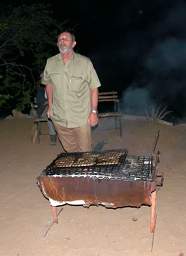 |
 |
| Neville tending to the Braii | Braii; Juan, Neville, Xxx | ||
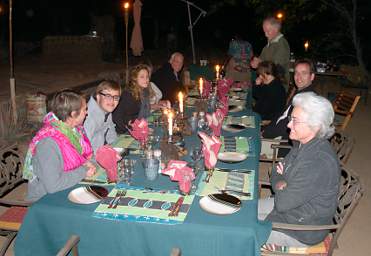 |
 |
| Huab Braii Table | |
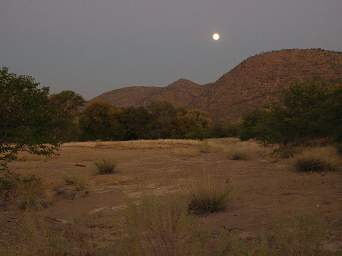 |
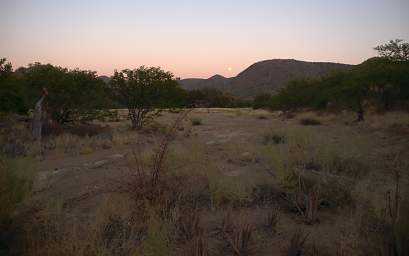 |
| Huab Moon | |
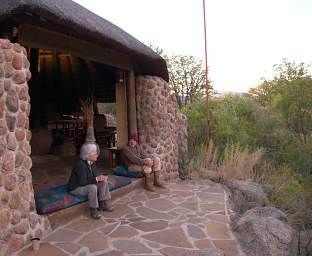 |
| Dona and Jan warming up before a morning walk |
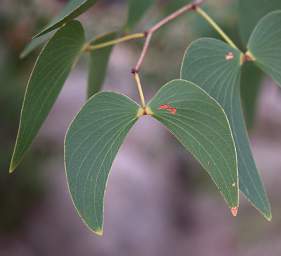 |
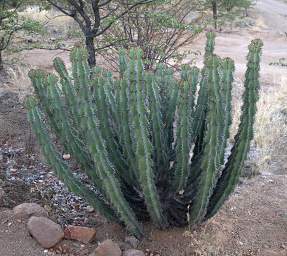 |
| Mopani Tree Leaves | Cactus used for Poison Arrows |
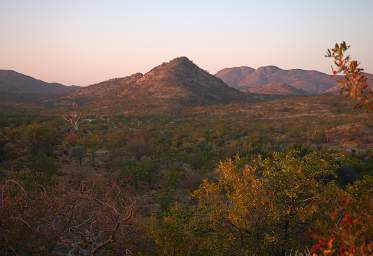 |
 |
| Morning at Huab | |
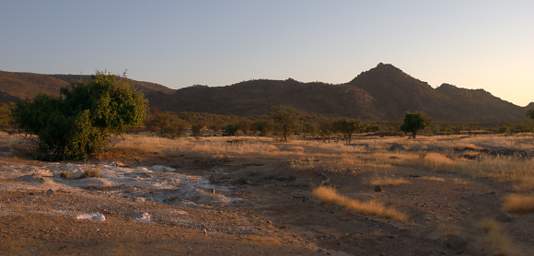 |
| Morning at Huab |
On our last morning's walk we came across a place in the sand, not in the riverbed, where animals had dug down to water. It wasn't clear which species had dug the hole, as everyone had been using it once it was dug. We learned in Tanzania that sometimes elephants will dig a hole to get to clean water rather than drinking out of an already exposed but well trampled water hole.
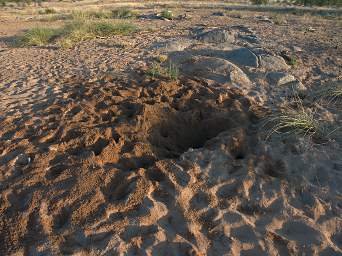 |
| Water Hole dug by animals |
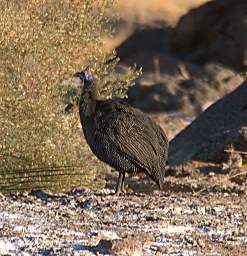 |
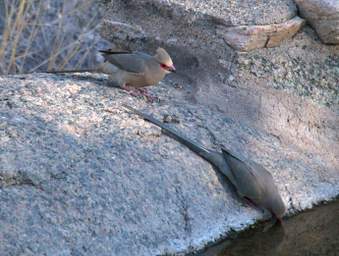 |
| Helmeted Guinea Fowl | Red Faced Mousebird |
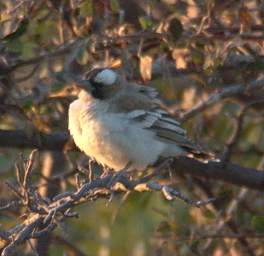 |
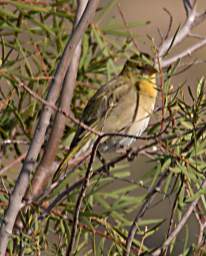 |
| White Browed Sparrow Weaver | Xxx Weaver |
 |
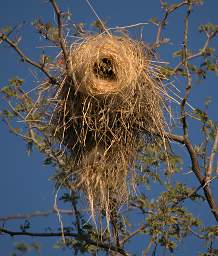 |
| Weaver Nests | |
All too soon, it was time to leave. Susie and Jan were great hosts and Huab Lodge is a wonderful spot. We highly recommend it.
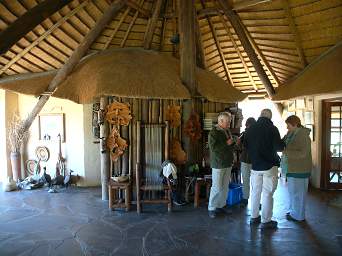 |
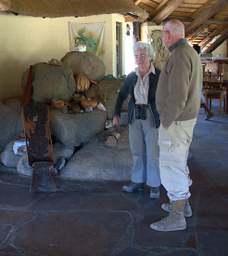 |
| Inside Huab Lodge | Dona and Jan |
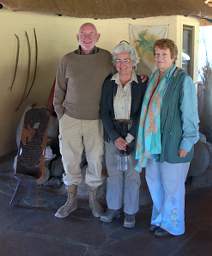 |
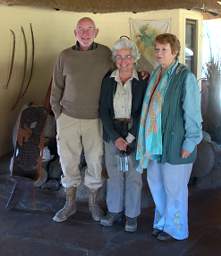 |
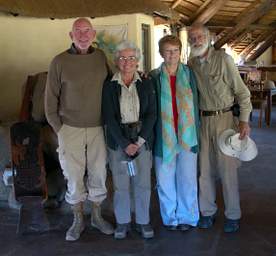 |
| Jan, Dona and Susie | Jan, Dona and Susie | Jan, Dona, Susie and Gary |
We had a liesurely drive back to Ohangwena, looking for birds and other animals and enjoying the Namibian landscape.
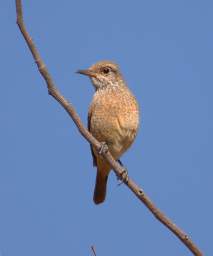 |
| Bird Xxx |
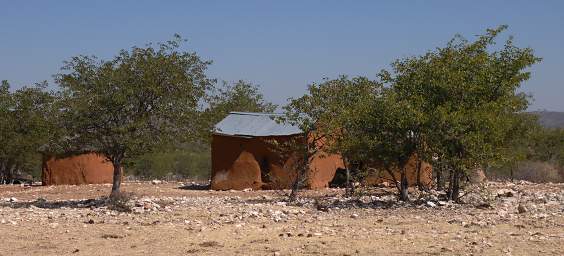 |
| Damara Houses |
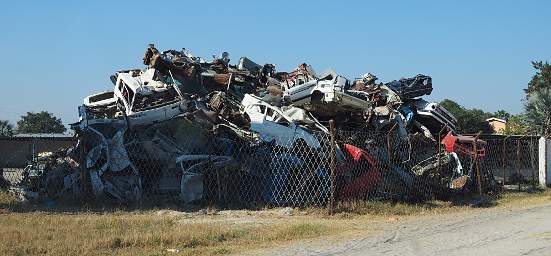 |
| Pile Of Car Bodies outside Ondangwa |